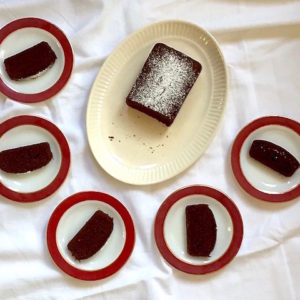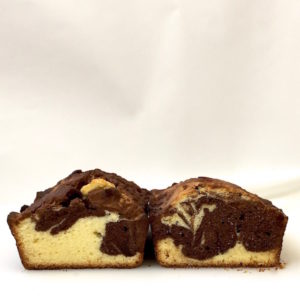Perfect Pound Cake Variations
You are either a baker or a cook. Very few people are both.
Merrill Stubbs, A New Way To Dinner
I believed the above until my late forties. Then humiliation got the better of me and I taught myself to bake. Because I was in my late forties–I am fifty now–it never occurred to me to consult the internet for instruction. Instead, to paraphrase Joan Didion, I worked up the literature.
 In dire need of re-ordering.
In dire need of re-ordering.
Eventually even the most bookish must head for the kitchen. It was Ruth Reichl’s Perfect Pound Cake, or more accurately, the way she wrote the recipe, that gave me courage to bake. A mere three-quarters of a page, Perfect Pound Cake is both a primer on concise recipe writing and a tutorial on baking.
Beat the butter at high speed in a stand mixer until it’s fluffy and starting to turn white; it is not possible to overdo this step, which should take at least five minutes.
White? Five minutes? Each ingredient–the sugar, the four eggs responsible for leavening–is added gradually. Eggs need to “become one with the butter.” People like to say baking is science and cooking is art, but baking Perfect Pound Cake taught me that cakes aren’t so dissimilar from stews: each are built.

By following Reichl’s instructions, I had myself, true to the title, a perfect pound cake. And I was ridiculously proud.

The very first Perfect Pound. Photo taken in 2015.
Over the next three years I baked Perfect Pound Cake countless times. Even as my confidence grew and I branched out to more complex cakes (the scrumptious chocolate flourless number in Diana Henry’s Simple, David Lebovitz’s Cocoa Marzipan Pound Cake) whenever time was short and I needed a cake, I turned to Reichl’s recipe.

Yet another early attempt.
Reichl calls pound cake “the little black dress” of cakes, and truism though it is, she’s right. Like a little black dress, Perfect Pound Cake pairs well with almost anything, never goes out of style, and keeps well. Even my husband, neither morning person nor morning eater, can be coaxed to nibble a slice before noon.

(Actualy photo of John before noon. See clock, left. Granted, not eating pound cake.)
In time I began tinkering with Reichl’s recipe. Vanilla extract got swapped out for almond, then hazelnut. I added the odd handful of chocolate chips. Come colder weather, I sharpened the cake with lemon juice and a confetti of candied lemon peel. I stirred in spoonfuls of lemon curd. Sometimes leftover fruit found its way into the batter. But most often I dumped in jars homemade jam. The cake took whatever I threw at it in stride.

(And that’s they way they became the…never mind.)
There is a marble version of this cake, too, but I’ll give that recipe separately, or this post will rival a Karl Ove Knausgård novel.

Finally…. My health of late has resembled Cedar Point Amusement Park’s Wicked Twister Roller Coaster Ride. Rather than fall on my fainting couch whining, or penningThe IK’s Struggle, I’ve begun reworking recipes to ease my cooking life. If a dish or bowl may be used multiple times without washing, a recipe will reflect this. Stars * denote places where breaks are possible–a moment to sit down, catch up on the lastest lunacy masquerading as American government, perhaps pour yourself the merest drink before carrying on with the business at hand: cooking.

—
Please read recipe through before beginning to bake.
Ruth Reichl’s Perfect Pound Cake with Variations
Adapted from Ruth Reichl’s My Kitchen Year
yield: 1 nine inch/23 cm cake
Baking time: one hour
1 cup/2 sticks/8 ounces/227g unsalted butter, at room temperature. (See notes)
2 cups/450g cake or all-purpose flour
4 large eggs
1 teaspoon vanilla extract
1 teaspoon baking powder
pinch of salt (about 1/8th teaspoon)
3/4-1 cup/ 170-227g sugar (see notes)
Additions to consider:
handful fresh blueberries
fresh pitted cherries
chocolate chips: bittersweet or milk
break up four ounces/100g of halvah and scatter it over the cake just before baking
4-8 ounces/100-225g strawberry or cherry jam
juice and peel of an organic lemon
1-2 tablespoons lemon curd
candied lemon, lime, or grapefruit peel
nuts
substitute the vanilla extract for hazelnut, lemon, almond, or Amaretto
All ingredients must be at room temperature before you begin. Most importantly, butter must be soft. Remove it from the refrigerator at least four hours before you plan to bake. Eggs will hold on your counter for an hour or more, unless you inhabit a sauna.
Butter wrappers make ideal pan-greasing implements.
If you are terrible at cracking eggs (Hi!), use two bowls: crack one egg at a time into the first bowl. If you get shell in the egg, use half an eggshell to pluck it out. It works. Then pour the eggshell-free egg into the second bowl; proceed in this manner until all four eggs are in the second bowl.
—
Preheat oven to 350F/180C
Unwrap the butter and dump it in the mixing bowl of the stand mixer. Use the butter paper to grease a 9inch/two pound/23 cm baking pan (or just grease the pan with butter).
Now measure the flour, baking powder, and salt into a large bowl and stir it with a large metal spoon or whisk. Set the bowl and the unwashed measuring cup aside.
*
Set two medium sized bowls or measuring cups into the sink. Crack each egg into first bowl, one at a time, removing any bits of shell with half an eggshell. Transfer the clean egg into the second bowl. Proceed until second bowl has four eggshell-free eggs. (If you are an expert cracker of eggs, feel free to use a single bowl.) Set eggs beside mixer.
Measure vanilla or extract of your choice into the eggs.
Measure sugar into cup you used to measure flour.
If you are adding anything to the cake, have the addition ready on the counter beside the mixer.
*
Now start beating your butter. Using the paddle, set the mixer on high speed and beat butter for at least five minutes. As Reichl says, you cannot overdo this: the butter should turn white. While it mixes, clean up.
Gradually add the sugar. You may need to stop the mixer to scrape down the bowl and beaters.
Keeping scraping down the mixing bowl if necessary. Once all the sugar is added, tip in the first egg. Allow each egg to blend completely before adding the next. As the third and fourth egg go in, the butter may appear to curdle. That’s okay. Once you add the flour the batter will cohere.
Reichl recommends adding the flour by hand. I find it easier to add the flour in three batches, giving the mixer a few turns on low speed. Whatever you choose–adding flour by hand or mixer–be gentle but firm, and don’t overmix. You don’t want to lose all the air or toughen the cake.
Now gently fold in any additions, swirling carefully through the batter. Or just leave the cake well enough alone.
Using a large metal spoon, dollop the batter into the baking pan. A spatula is helpful to scrape remaining batter from the bowl without deflating. Smooth the cake as best as you can–I make a horrible mess–and slide it into the oven.
Bake for about 60 minutes. A tester will come out clean. Place pan on a rack to cool. After about 20 minutes, remove cake from pan. Allow to cool completely before eating.
Perfect Pound Cake will keep, well-wrapped, up to five days at room temperature. Freezes well up to three months.
Notes:
Cake flour is lower in protein than all purpose flour, leading to a finer-crumb. All purpose works perfectly well here–I’ve used it often.
Reichl recommends a high-fat cultured European butter like Plugra. I most often use Kerrygold, but have also plain old American butters with good results.
Some of the suggested additions to the cake contain a great deal of sugar themselves. In these cases I prefer reducing the amount of sugar in the cake to 3/4 cup. This is a question of personal taste. Do not go below 3/4 cup or the cake structure will suffer.





